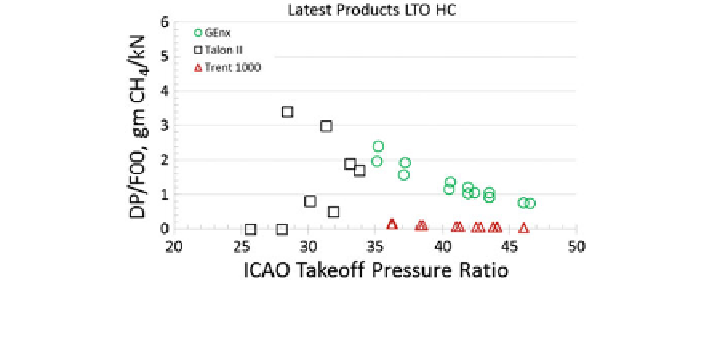Environmental Engineering Reference
In-Depth Information
Talon1000 which has 15 % margin from CAEP/8. In summary, the LTO NO
x
of the
N + 2 product at 30 OPR will be 15.6 g NO
2
/kN giving approximately 85 %
reduction from the
first generation modern aviation engines listed in the ICAO
engine emissions database. The low-OPR GEnx meets the N + 2 product goals;
however at
50 OPR, it needs to reduce LTO NO
x
by approximately 50 % in order
to meet the proposed CAEP/18 goals, namely
≥
. However, if the GE
N + 2 technology can be transitioned successfully into product, then it will have
approximately 75 % margin from the future NO
x
regulatory standard. In other
words, no new NO
x
technology innovations are required other than the general
challenges with transitioning it into products effectively.
Low-power combustion ef
—
37.763 + 2
ˀ
ciency, CO, and hydrocarbons were other major
concerns of the
first generation lean domes which have been successfully resolved
in the second generation as summarized in Figs.
29
and
30
in terms of average LTO
HC and CO. The data for TALON II and Trent1000 are also shown in order to
facilitate a back-to-back comparison between the best rich domes and GEnx. For all
practical purposes, GEnx performs as well as the rich domes; both have signi
cant
margins from the CAEE baseline standards, namely 19.6 g CH
4
/kN and 118 g CO/
kN. The comparison between the smoke regulatory standard in terms of maximum
SAE smoke number
, is presented in Fig.
31
for both the rich and
lean domes; the latter are expected to produce considerably lower values than the
former. But that is not the case with the GEnx engine tested in 2009. Since the
characteristic smoke numbers of GEnx and the best of the Rolls Royce rich domes
including RR Phase 5 and Trent1000 are essentially comparable (Fig.
32
), we have
plotted the average smoke numbers of Trent1000 and GEnx, respectively,
83
:
6
F
Min
;
50
0
:
274
in
Figs.
33
and
35
for each of the four parts of the landing
-
takeoff operation, namely
takeoff, climbout, approach, and idle.
Fig. 29 Landing
-
takeoff LTO HC of the latest engines (viz. GEnx, TALON II and Trent1000)
versus ICAO takeoff pressure ratio. Average landing
-
takeoff unburned hydrocarbons may be
compared to the standard, 19.6 g of CH
4
/kN rated takeoff thrust


Search WWH ::

Custom Search